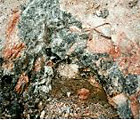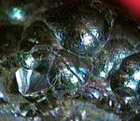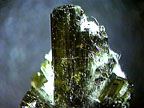

![]()
Volume 1, Issue 4
- Bancroft, Ontario: Canada's Mineral Capital
- Gold Deposits in the Madoc Area of Eastern Ontario
- The Madoc-Bancroft Geological Corridor of Eastern Ontario
- Lapidary Materials of the Bancroft Area
- A Lesson for all Rockhounds
- Ontario's Spectralite Mountain
- The No. 22 Dyke
- Mineral Collecting in Mexico
- The Foothills Erratics Train
- A Rocky Mountain Mystery
Welcome to the fall edition of the Canadian Rockhound! It's amazing how quickly the year has gone by. This issue ends the magazine's first year with a series of articles on the minerals and geology of the Bancroft-Madoc region of Ontario, Canada. In September, many of you on the Rockhounds Mailing List showed a great interest in Bancroft. I hope the articles presented in this issue will be enjoyed by all. Some of you may want to consider collecting around Bancroft next summer, or go on a tour during the Gemboree. But, whatever you do, keep safety in mind on any field trip. One author presents her story about a field trip that almost ended in disaster.
This past summer, the Canadian Rockhound received a special award from the Gem & Mineral Federation of Canada for its contribution to the rockhound community. The magazine has become an increasingly popular site for rockhounds, with well over 5000 visitors since January 1997. I plan to continue the magazine in 1998 and count on your contributions and continued support in producing a high quality internet magazine.
Once again, the magazine continues to bring more Canadian content. Many thanks to authors Liz Askew, Walter Bowser, Bob Bredberg, Yannick Dain, Sandra Downs, Ben Hyman, Tim Jokela, Daniel Mahoney, Doug Miller, Murray Nicholson, John Ratcliffe, Larry Rush and the Mineral Society of Manitoba for their contributions. I hope everyone will enjoy this outstanding issue. I wish everyone a happy and safe Christmas holiday!
Dirk Schmid, Editor
E-mail
Bancroft
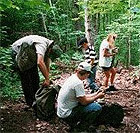 Collecting near Bancroft. Photo courtesy of Sandra Downs.
|
Canada's Mineral Capital
By Sandra Downs
Over 300 different types of minerals are known to occur in the Bancroft area. Mineral collectors can still find beautiful specimens at some of the abandoned mine sites. Sandra Downs provides a brief guide to collecting in the Bancroft area.
Gold Deposits in the Madoc Area
of Eastern Ontario
By Bob Bredberg
The first discovery of gold in the Canadian Shield took place at Eldorado near Madoc in August of 1866. The small community soon found itself at the center of a gold rush as thousands of hopeful prospectors arrived from California, Australia, Europe and the United States. Bob Bredberg looks at the gold deposits and their interesting geology and mineralogy.
The Madoc-Bancroft Geological Corridor
of Eastern Ontario
By Bob Bredberg
The Madoc-Bancroft geological corridor represents a highly diverse assemblage of rock types which change rapidly over short distances. An estimated 94% of all minerals known to exist on earth can be found in this region. Bob Bredberg looks at the origins, geology and mineralogy of the corridor.
Lapidary Materials of the Bancroft Area
By Tim Jokela
Tim Jokela provides a brief guide to collecting sites for lapidary materials in the Bancroft area.
Rockhounding & Mineral
Collecting
A Lesson for all Rockhounds
By Liz Askew
Imagine you are on a field trip with a club. Do your fellow club members know where you are? For Liz Askew, being left behind in the desert nearly resulted in death.
Spectralite Mountain
By Ben Hyman
Spectralite Mountain, situated near Marathon, Ontario, is a known source of spectralite, a feldspar mineral that exhibits labradorescence. Good material can be used for lapidary work. Ben Hyman reports on his recent collecting trip to the site.
The No. 22 Dyke
By Richard Gunter
The No. 22 pegmatite dyke near Cross Lake, Manitoba, contains a number of very rare minerals, not all of them described, plus some interesting variations on common minerals. Richard Gunter looks at the mineralogy of this unusual pegmatite dyke.
Mineral Collecting in Mexico
By Walter Bowser
A comprehensive safari trip summary to Mexico's best mineral
collecting areas.
formidable site minéralogique français.
Canadian Landscapes
The Foothills Erratics Train
By Murray Nicholson
Scattered on the plains in front of the Rocky Mountain foothills are tens of thousands of large boulders, the extraordinary remains of the ice age in Alberta. These boulders are part of the Foothills Erratics Train, a narrow area extending 600 kilometres southeast from Jasper National Park to the international border. Murray Nicholson explains this phenomenon.
A Rocky Mountain Mystery
By Murray Nicholson
The Rocky Mountain trench extends from Flathead Lake, Montana to the Liard Plain near the Yukon border. The Trench marks the western boundary of the Rocky Mountains. The origins of the Trench as a whole still remains a mystery. Murray Nicholson reports.
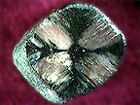 Andalusite. Photo courtesy of theImage.com.
|
By Doug Miller
Andalusite is a mineral that occurs along the Hanson Lake Road in Saskatchewan. A variety of andalusite, called chiastolite may also be occasionally found in some places.
Hematite
By Richard Gunter
Hematite is a very common mineral. In Manitoba botryoidal hematite occurs at Red Cliff on Black Island, the oldest known mineral deposit in the province.
Rubellite
By Richard Gunter
Tourmaline is a relatively common mineral at the TANCO pegmatite mine, Bernic Lake, Manitoba. It occurs as black schorl crystals in the wall zone, and as disseminated elbaite crystals. This article describes Rubellite, a third type of tourmaline found in the spodumene zone this year by Peter Vanstone, TANCO's chief geologist.
Hackmanite
By Sandra Downs
Hackmanite is one of many minerals found at Bancroft, Ontario, and at Mont Saint-Hilare, Québec. One interesting property of this mineral is photochromism.
Potash
By Doug Miller
Potash is Saskatchewan's official mineral. It's not hard to see why. Saskatchewan's potash deposits, which were left behind by an ancient sea, are of economic importance to the province. About 10 million tons of potash ore are produced each year by the province's potash mines.
British Columbia Fossil Bed Locations
By John Ratcliffe
This article presents a list of fossil collecting sites in British Columbia. The list was compiled by John Ratcliffe of Kamloops, British Columbia. Maps of these collecting localities may be purchased.
Index to Desert Magazine Published
Desert Magazine, published from 1937 to 1985, contained a huge amount of information about American deserts. Those who are aware of this source and have back issues are continually frustrated by lack of an index to the magazines, making it nearly impossible to use the issues for any kind of research. Such an index has now been published.
Touchstone
A poem by Daniel Mahoney.
Rockhounds
A poem by Larry Rush.
Adamas Gemological Laboratory - Premier Mine
An online tour through the De Beers Consolidated Mine's Premier Mine, located in Cullinan, South Africa. The Premier mine yielded the world's largest cut diamonds, the 530.2ct Great Star of Africa, and the 317.4ct Lessar Star of Africa.
British Columbia & Yukon Chamber of Mines
This website contains a collection of online resources for prospectors, mineral explorationists and earth science enthusiasts. The site includes links to mining and prospecting related sites as well.
Cyberwall Rock Collecting in Canada
This page lists several mineral collecting localities in Ontario and Québec. the minerals generally found at these sites are mentioned as well. The site includes a discussion on the Bancroft region.
Mineral City Exchange
MinCity is a website maintained by members of the Nova Scotia Gem & Mineral Society. This site features articles on mineral collecting, an online mineral auction, and links to other websites.
Mineral Collecting at Bancroft
This site is maintained by the Bancroft Chamber of Commerce and contains information on mineral collecting localities around Bancroft, Ontario.

Copyright © 1997 Canadian Rockhound
Images of minerals are Copyright ©1997
theImage.com
unless otherwise noted.
Magazine Issues |
News & Events |
Junior Rockhound |
Resources
Clubs |
Dealers |
Classifieds |
Links |
Home
